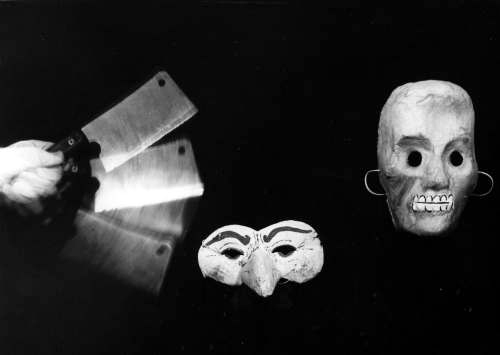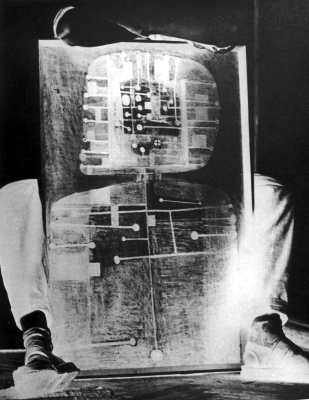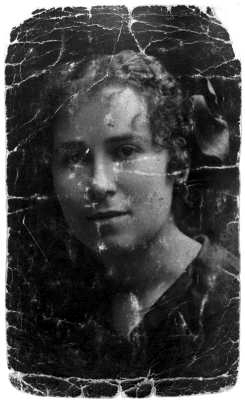6 - 28 II 1998


From the series " Photo Theatr" - 1957
![]()
![]()
6 - 28 II 1998


From the series " Photo Theatr" - 1957
The archaeology of photography I call activities claiming to discover, investigate and comment events, facts and situations, held in the past, in so called photographic past. Through photography, continuity of the visual contact with the past extends the influence of old, culture - creating layers into the present. This transmission in time is the basic motive of different photographic discoveries. Maybe, all contemporary audio-visual activities determine future possibility of catching the time and form of life. For the cognition of the Unknown is impossible, we can only come closer or further to the truth. Many archaeological researches are based on this pulsation, which sometimes recalls breathing or heart-beat. The goal of the archaeology of photography is to find witnesses of old events. Such a witness is light. The light, being a stimulus of technological processes, fixed old reality, sculpted it in a negative. So, the negative is the trace of "that" world and an authentic witness of the past events. Observing the light left in a negative can be the subject matter of many fascinating discoveries, revealing the mystery of the negative's sculpture!
"Caution" - 1958
Discovery:
The Orthodox Church cemetery in Sosnowiec. A monument presenting a woman in a long dress, walking away into the past and closing the door. I am taking many photographs of the monument trying to guess the sense of the mystery cast in the sculpture. After 20 years, at last, I discovered the past. The woman was the wife of a man called Brandenberg, who was Prussian manager of the ironworks. She was born in Yalta in Russian aristocratic family. During the World War I she was arrested for helping Russian captives and died of heart-attack. The husband ordered the monument in Dresden. He died a few years later during the revolutionary riot in Sosnowiec. These tatters of the past are only approximation. The photograph of a woman in Caucasian national costume and the other - silhouette of the same person in a trailing dress. These photographs helped to uncover the past.
Jerzy Lewczyński

Lewczyński's Archaeology of Photography
What is photography? What is taking photographs? A famous French critic Roland Barthes at the and of his latest book makes apparently helpless confession: " I have to accept, as a rule, the fact that I cannot fathom or penetrate photography". I defined his confession as "apparently helpless", because the concern of the author, who leads his readers through over forty chapters of his book "The Light of the Picture", very precisely, as befitted the structuralist writer, presenting his observations, approximations and analysis, is rather on attractiveness of the way to the aim, not on the very aim. All his recognitions, inspections and reflections sooner or later drive to a simple but striking statement which is the essence of what is presented on the photo: "here - what was". The boundary between evidence and non-evidence is tremendously delicate. Yet every photo, treating an out reality of things, paradoxally underlines and intensifies our meeting with time, changing our contact with what is presented into a phenomenon; there is an essential sign of experience in it: the truth about existence focused for a moment in the flash of light. So, Barthes not without reason writes about it using capital letters.
"Rogatywka" (Four-cornered cap) - 1958
Unusual popularity of taking photographs trivialized and in a sense used up the attractiveness of both finding ourselves in the moment when the camera lens aim at us and the moment of our contact with the very photo. It takes time and a sort of celebration to experience again that traumatic feeling connected with the insight into ephemeral reality of "that-what was". The power of a photograph is cumulated not only in subject presented. It reaches the depth of our solitude: life objectified for a moment requires from us the answers to problems we are experiencing here and now. Standing in front of them we are often not attentive enough and yet rather helpless. We are often bored by collective watching photographs - it is like telling someone else's dreams - sooner or later it makes us indifferent and tired. The photograph wants to be tete-a-tete with us, even the most banal photo from our father's identity card or from our grandma's wedding... Perhaps such a photo needs privacy the most, more than photographs subjected to press commentaries or evaluating poetics of the exhibition contexts. The magic of these photos seems to be based on changing imaginative returns into intensified meetings of reality; it is like depositing the value of silence - still not well understood and not appreciated enough - within ourselves and outside; it is like being wrapped with our breath petrified.
Negatives (fragment) - 1971
The first significant exhibition-show of Jerzy Lewczyński was done together with fascinated by photography Zdzisław Beksiński and Bronisław Szlabs at the Photographic Society in Gliwice and titled "Antiphotography". From the very beginning the author has been searching for something what could be called poetry and grammar of photography. In his best works, having a sort of poetic respect for every photo, Lewczyński tries to reveal that the reading matter of vision, applied to photography, becomes the reading matter of the world and the reading matter of the experiencing subject. Reading matter implies interpretation. The artist tries to show not only the process of creation but also the rules of reading the photographs; he reveals them and treats as cognitive and aesthetic trump card. One of his most famous photographs "Neisse 1945 - our enlargement", done in 1971, retaining the dramatic value of the subject, shows, that every approach to fragmented reality becomes the pretext for conscious self-vivisection of his outlook, causing great aesthetic result. From the beginning of his artistic work Lewczyński has overcome conventionality of understanding photography. His starting point seemed to be relatively simple: think about photograph as a form, which is the only and the most Important artistic task. In consequence, the existential approach is applied not to the subject but to the process of think- ing and working over a photograph. Characteristic feature of Lewczyński's works is appreciation of synthetic shortening and precisely revealed analysis. I think, that his work in the field of photography in the sixties could be compared to so called automatic writings, where writers were describing their adventures with form: they were creating poems about writing poems and novels about difficulties of writing, deliberately showing the "seams" of the apparently homogeneous and devoided of problems structure created by the language and the world presented.
Hospital (fragment) - 1970
Both, Lewczyński's photographs and mentioned above efforts of writers had in common categorical resistance against mimetic claim of art, which during socialistic realism used to call reality something what was in fact unreal. Modern photography, such as Lewczyński's, and novel or poetry after the experiences of totalitarianism, very consciously marked the autocritical distance. It is worth noticing that the author of "Neisse 1945 - our enlargement" searching for borders and limits of reproducing the world, has never lost existential or even metaphysical values of his art. Certain aura of mystery and magic is spread over the works, even the most vanguard, of the artist from Gliwice. One of the most important and distinct trends in Lewczyński's works is something, called by the author "archaeology of photography", what can be shortly defined as restoring meaning to things that were rejected, disregarded, doomed to oblivion or being at the mercy of fortune. He is fond of specific "life after life" of photography; old abandoned photos, negatives found at lofts and in drawers, with holes eaten by moisture, are changed by the artist into a sign of culture, full of existential meaning and documental value. Specific "hero" of many photographs and photo-compositions is not the human helplessness in front time "written" by the lightnin human figures, things and events, but the very activity of time marked by damp pathes, moisture, tears, folds of paper and marks of dirt and mould. These are trying to destroy every attempt to catch - at least for a moment - the life. The photographs and negatives, found by chance in different nooks and corners are subjected to chemical treatment and risen to a dignity of an artistic event. ringing to life the world of Feliks Łukowski a pre-war peasant photographer from Zamość area, was one of the most magnificent adventures of the artist.
Negatives finded in N. Y. - 1980
"Thousands and millions of seconds - wrote Lewczyński in 1939 - preserved in the matter of negative make endless range that girdles our existence about. The pictures run like electrons around atom's nucleus. Constantly and forward in an unknown direction and rhythm - they mark the roads of our life. Supposedly, photography ... existed before the technological process were discovered - it existed in our ancestors minds as a trace of inner projection. What creates that infinite and mysterious aura around it? Sometimes, apparently fragile and easy to damage paper, behaves like the best marble of Carrara; it acquires the value of old and precious matter. This can be observed when watching and touching old photographs. Then, the traces of damage and touch decide about the strength of the transmitted picture". Jerzy Lewczyński's concern is on tention between continuity and fragmentation of our experiences. He is interested in phenomenon of memory confronted with irrevocable dynamic of changes in the passing time. Work over photography become for him, more or less consciously practised, philosophy of this art. His achievements prove that the truth about life, the world and values cannot be separated from it.
Kazimierz Nowosielski
translation by Hanna Korolczuk

Copyright ©1998 Jerzy Lewczyński, Kazimierz Nowosiekski, Hanna Korolczuk, Galeria FF ŁDK